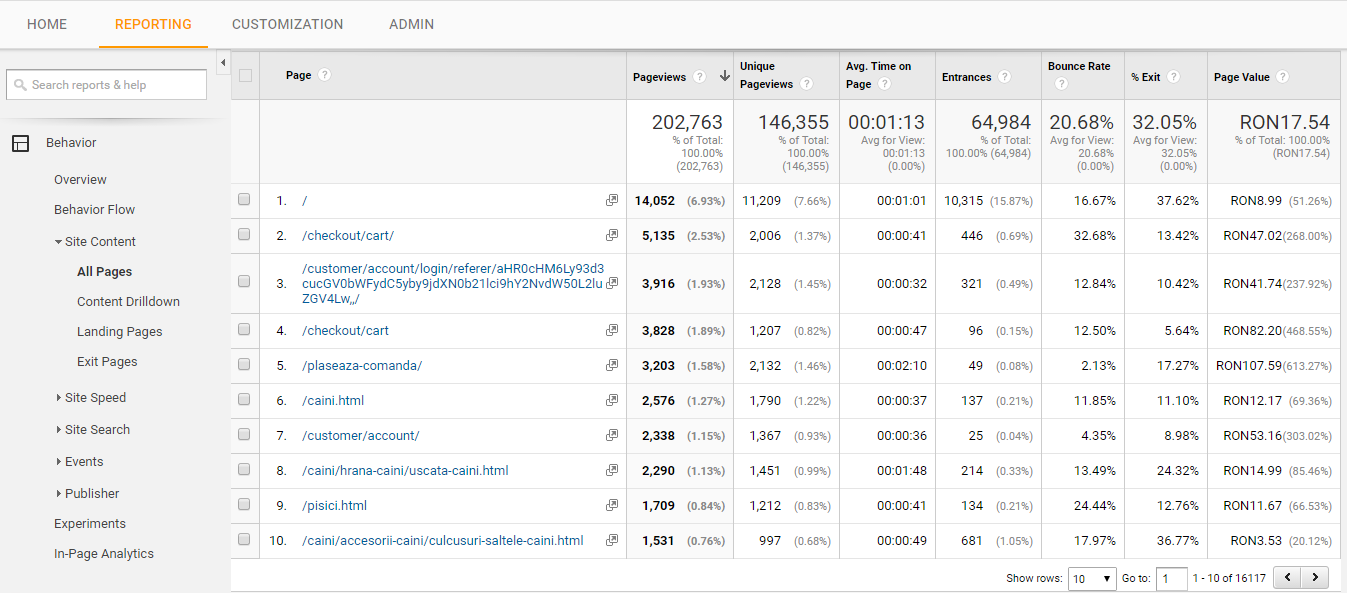Google Analytics can help in many ways, by telling you how your website is performing.
In this article, we will be talking about Bounce Rate and Exit Rate. What they are, what differentiates them, and how these metrics can help us.
We also have two visuals that can make the difference easier to understand.
Let’s see what we are talking about!
What is bounce rate?
A bounce happens when a visitor enters your website, and leaves from the landing page, without visiting anything else on the site.
The more bounces, the higher the bounce rate (the percentage of single-page sessions).
Let’s put our imagination to work.
Meet Auba! Below you can see him entering and leaving a web page.


A visitor can bounce in a lot of ways:
- by closing the browser window;
- by typing another URL in the address bar;
- by clicking the back button taking him to the previously visited site
- and so on.
You can check the average Bounce Rate in the Audience – Overview report.


What is Exit Rate?
Exit rate represents the percentage of visitors who click away to a different site from a particular page, after having visited any number of pages on your site.
Let’s assume that Auba enters your site, then goes to a specific page, then to another, then to another and then leaves.
The last page from this journey is considered an exit page, and it will contribute to determining Exit Rate.
Here you can see Auba wandering through the site, from one to two or more different pages. The last one is the exit page.


To check the exit rate in Google Analytics, you can go to Behavior – Site Content – All Pages.


You can use segmentation to see more of what you’re interested.
You can also set the device category or traffic source as secondary dimensions to give you a better understanding of why visitors leave your site.
I’ll give you a hint to check faster the bounce rate and the exit rate, without entering a new tab.
Google Analytics extension for Google Chrome can show you live data for the page you are on.


What might increase bounce and exit rates?
- 邪魔なポップアップ広告や音楽、
- ページの読み込み時間が長い (人々は約 10 秒であきらめる)、
- 探しているものと関連のないコンテンツ、
- デザインが悪い、読みにくいフォント、
- ウェブサイトを簡単に使えない、
ビジターが必要としている情報を得て、ページを離れてしまうと終了率が高くなる可能性があります。
ですから、ブログ、シンプルなプレゼンテーションサイト、Q&A などでは、平均より高い直帰率が目に付くでしょう。 あまり気にしないでください!
StackOverflowやQuoraのようなサイトは、常に高い直帰率になります。
だからといって、そのサイトが悪いということでしょうか?
高い直帰率を持つ Web サイトでは、ユーザーが Web サイトに費やした時間は、真実からかけ離れている可能性があります。
調整された直帰率
訪問者が必要なページに正確に到達するサイトのための代替案があります。
その考え方は非常にシンプルで、訪問者がページ上で一定の時間を過ごした後に送信される Google Analytics イベントを設定します。
この方法では、訪問者が設定した最小限の時間を過ごした場合は、訪問は直帰としてカウントされません。
直帰率と離脱率の違いとは
直帰と離脱は完全に異なる、独立した概念です。 混同しないようにしましょう。
- 直帰率は訪問者が最初に入ったページを指し、離脱率は訪問者が離脱する前に最後に訪れたページを指します。
- 直帰は常に 1 ページの訪問です。
- 低い離脱率は、そうかもしれません (ユーザーはサイト上の他のページに移動してから離脱しているはずです)。
- 直帰率はほとんどの Web サイトにとってマイナスです (ランディング ページが訪問者に関連していないことを指摘する)。
- 離脱率はプラスまたはマイナスのいずれかです (人々は特定の記事を読むためにオンライン ユーザー出版に駆り立てられるかもしれませんが、必要とするページを見つけて記事を読み、その後、離れていきます。
直帰率と離脱率はどのような値であるべきか
これは非常によくある質問なので、私たちの意見を述べたいと思います。
理想的な値などというものはありません。
訪問者が Web サイトを訪問し続けたいと思うべきであることを念頭に置く必要があります。
つまり、まず、邪魔な音や巨大なポップアップなど、迷惑なファーストインパクト要素の効果を無効にすることができます。
外部リンクは新しいタブで開き、セッションを邪魔しないようにする必要があります。
次に、最初のページに関連するコンテンツへのリンクを追加し、使いやすい読みやすいメニューを構築します。
そして、最も重要なことは、コンテンツが、訪問者がそのページで見つけることを期待しているものに関連していることです。
離脱率を下げるためにすべきこと
まず、離脱する理由を調査しましょう。
オンラインショップであれば、退出ページを最適化したいところです。
リンクを使って商品を関連付け、訪問者を他の場所へ移動させるのです。
彼らの好奇心に火をつけ、去るのではなく、探検したいと思わせることが、あなたのビジネスに素晴らしい効果をもたらします!
人々がショッピング目的のためだけにモールに行くと思いますか?
そのすべてではありません!
trong style=”border-top:solid 1px #deddd; float:solid 1px #deddd; float:solid 1px #deddd; margin:solid 1px #deddd; margin:solid 2px #deddd; margin:solid 2px
これは、あなたのウェブサイトやオンラインストアで再現してみるべきことです。
それができれば、あなたは勝てるでしょう!
ユーザーの行動を監視する
より技術的な方には、inspectlet、hotjar、clicktaleなどのライブトラッキング/ヒートマップソフトをインストールすることをお勧めします。
これらのソフトウェアは、ユーザーがどこでたむろしているか、どこをクリックしているかを確認し、ユーザーの旅をよりよく理解するのに役立ちます。
訪問者が次に何をすればよいかわからないと感じたら、行動喚起についても考えてみてください。
訪問者が次に何をするのかわからないと感じたら、行動喚起についても考えましょう。
留意点
直帰率と離脱率は、サイト上で何かがうまくいっていないということを示すものとして捉えましょう。
常に他の要因に左右されるので、行動を起こす前に確認する必要があります。
どちらも、ユーザーの満足度が疑われるときに点灯する電球のように、役に立つと考えてください。
最後に、Google Analyticsでこのように感じることがあったら教えてください。